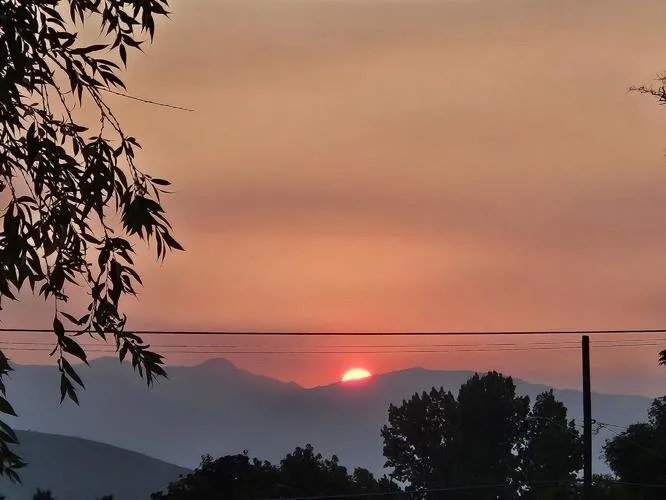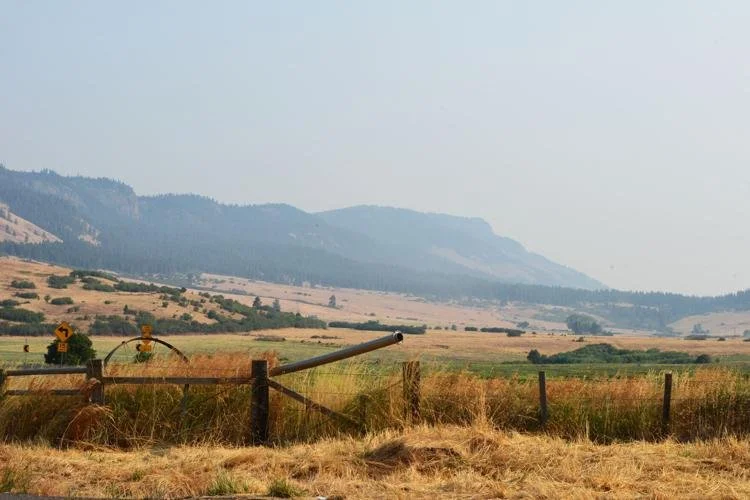Seasons of smoke
As research probes long-term impacts, here's how to ease exposure
By Ellie Graham
Smoky skies engulf Elkhorn mountains. Pictured by/Lisa Baker
Summer in the West is becoming a season of house arrest, as smoke from wildfires chokes the skies and experts say the best way to avoid it is to stay indoors.
In 2020, wildfires in Oregon created some of the worst air quality in the nation. Last year was a milder wildfire season. But this summer, the smoke is back — earlier and thicker, focusing fresh attention about what impact it has for the health of Oregonians.
“People need to be prepared for hotter smoke here, longer fire seasons that go from the spring into the fall, and they need help in getting their homes to be a safe place,” said Gabriela Goldfarb, a public health manager with the Oregon Health Authority.
Knowing how to navigate inevitable smoky wildfire seasons is a skill Oregonians are becoming all too familiar with. Meanwhile, researchers are exploring the long-term effects of exposure to wildfire smoke — and governments are grappling to find long-term solutions to protect residents.
Health impacts
When air quality warnings are issued by the state Department for Environmental Quality, the warnings typically focus on “sensitive” groups — people who may be more likely to suffer health effects from smoke. That includes people with chronic conditions such as asthma and heart disease, as well as children and older adults.
But the smoke also affects people without underlying health conditions as well.
Experts say wildfire smoke contains tiny particles known as PM2.5 that can get into the lungs and bloodstream.
Immediate health effects from inhaling these small particulates can include headaches, chest pain, fatigue, difficulty breathing, asthma attacks, irritated throat and persistent coughing. Studies also show that people exposed to smoke may experience temporary changes to lung function and experience shortage of breath.
Patients with preexisting lung conditions are also more likely to be symptomatic and have layers of underlying disease flare up during times of exposure to wildfire smoke, said Dr. Gopal Allada, an Oregon Health & Science University pulmonologist.
“We can see in the health data that more people are coming into emergency departments with, for example, respiratory illnesses when there's more smoke in the air,” Goldfarb said.
In addition to harmful pollutants, intense heat exacerbates the intensity of wildfire smoke, with the small particulate matter seeping deep into the lungs, said Goldfarb.
Health effects aren’t limited to the physical.
An increasing amount of research examines the mental health impacts of long-term exposure to wildfire smoke. The Oregon Health Authority says in its 2023 climate and health report that climate hazards can translate into psychological harm. There’s evidence that preexisting mental health symptoms may be exacerbated. The study cited in the report associates extreme heat and poor air quality with mental health issues ranging from stress to anxiety and depression.
Meanwhile, less is known about the long-term effects of exposure to wildfire smoke. But research into the topic is ramping up, as smoky skies become increasingly common during Western summers.
One 2021 study in the Journal of Climate Change and Health introduces some evidence that exposure to PM2.5 from wildfire smoke correlates with an increased risk of cancer. However, due to the small sample size, experts cautioned against drawing generalized conclusions.
A recent article in The Atlantic magazine cited a June study published in Science Advances in which researchers argued that “the likely toxicity of wildfire smoke” was a factor in more than 50,000 premature deaths in California from 2008 to 2018.
What you can do
The Oregon Health Authority has resources highlighting best practices for living with wildfire smoke. The agency stresses the importance of creating clean air spaces to reduce smoke exposure and some other simple tricks to reduce adverse impacts.
Keeping windows closed and using high-efficiency particulate air filters are at the top of the list.
Strenuous outdoor activity is also discouraged. Experts say that when a person’s respiratory rate is increased, more small and potentially harmful particulate matter is inhaled.
Creating clean-air spaces inside homes is essential as well.
Goldfarb, from the Health Authority, said anything that puts dust or combustion in the air of homes should be avoided. She suggests people minimize activities such as vacuuming and cooking with an open flame gas stove. Microwaves are a better alternative, she said.
Refraining from burning candles, smoking tobacco and using fireplaces, is also advised.
Goldfarb added there are low-cost ways to make do-it-yourself filters for people without access to ventilation equipment.
The Oregon Health Authority is working with the Oregon Legislature to roll out air filtration devices and portable air conditioners to those suffering from smoke pollution, Goldfarb said.
N95 masks (the number refers to the percentage of particles filtered out by the masks) are also effective to wear for people who have to go outdoors during smoky conditions, said Goldfarb and Allada.
“If you really go outside and the air quality is bad enough where you can smell it, you can taste it, it really is a strong recommendation to have one of these high-quality masks,” Allada said.
Experts say regular fabric masks are ineffective at preventing small particulate matter from seeping in, even if they do feel momentarily helpful in blocking out smoke.
Surprisingly, diet may also play a role in combating the health impacts of smoke exposure. Being intentional about the food people consume can be a protective shield, Goldfarb said.
“If you give your body a lot of fruits and vegetables, it actually makes it stronger to resist the negative impacts of wildfire smoke,” she said.
Mount Emily peeks through the haze on Aug. 2, 2024, outside La Grande. As wildfires burn earlier and hotter throughout the West, researchers are focusing on the long-term health effects of exposure to smoke. Pictured by/Isabella Crowley
Public health implications
Goldfarb said the amount of research into the long-term health effects of wildfire smoke is increasing, driven in part by the prevalence of wildfires in the West.
She said the Oregon Health Authority has been studying health impacts from wildfire smoke exposure for over a decade now.
“Unfortunately, we are seeing it now in real time, what the science has been telling us for many years,” she said. “We would be seeing air and more intense wildfire seasons as a result of greenhouse gases that are trapping heat and that are driving climate change effects.”
The Health Authority issues an annual report, “Climate and Health in Oregon,” which details lessons learned and initiatives in place to improve health outcomes for Oregonians. A substantial portion of the report is dedicated to wildfire and smoke intervention with an emphasis on increasing community resilience to climate hazards.
The report says wildfire smoke disproportionately affects some Oregonians. Communities of color, lower income people and tribal communities are hit the hardest, according to the report.
The 2023 report said that the Health Authority and the state’s Public Health Advisory Board (a body that provides leadership to the state’s public health system) have set goals for reducing health risks driven by climate hazards, such as wildfire smoke.
One of the goals is to have heat-related illnesses drop by 50% and heat-related hospitalizations dropping by 60% by 2030. Another goal is to see respiratory visits, including those prompted by smoke, to hospital emergency departments drop by 20% by 2030.
To that end, Goldfarb said, the Oregon Health Authority is awarding grants to organizations that perform home weatherization and repairs with the idea being to make houses resilient to extreme temperatures and shielded from wildfire smoke.
Meanwhile, the state Department of Environmental Quality monitors pollutants in the atmosphere and issues advisories as needed.
“As wildfire seasons continue to grow and scale in length and time, the DEQ becomes more equipped to issue air quality advisories and collaborate with our local, state and federal partners on knowing where to issue those air quality advisories, as well as intermittent smoke for particular areas,” said Antony Vorobyov, public affairs specialist at the Department of Environmental Quality.
The advisories are just part of the story, however.
OHSU’s Allada said at the local level, it’s vital to ensure that there are safe places for people to go during times of poor air quality.
Oregon is one of just three states that have rules governing on-the-job smoke exposure. (Washington and California are the other two.) But Allada said employers need to be aware of when wildfire smoke could affect other employees as well, particularly in cases involving workers with sensitive medical conditions.
Part of the state’s strategy to deal with wildfire smoke involves attempting to deal with the climate change that increasingly is fueling fires that burn with more intensity.
For example, in July, Oregon was awarded $200 million in federal grant money under the Oregon Climate Pollution Reduction Implementation Grant. The money is intended to go toward addressing climate change through the reduction of greenhouse gas emissions across the state.
In the meantime, experts said there’s more work to be done in understanding and alleviating the health effects of wildfire smoke.
The Health Authority’s Goldfarb said the increasing interest in research about wildfires and smoke impacts is a positive sign.
OHSU’s Allada agreed: “As long as our government can have funding streams that go to people studying it, I think that's really important.”

